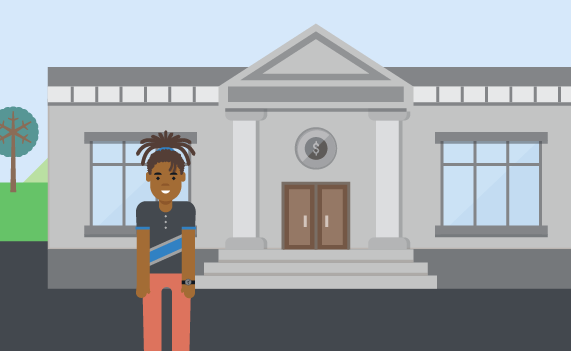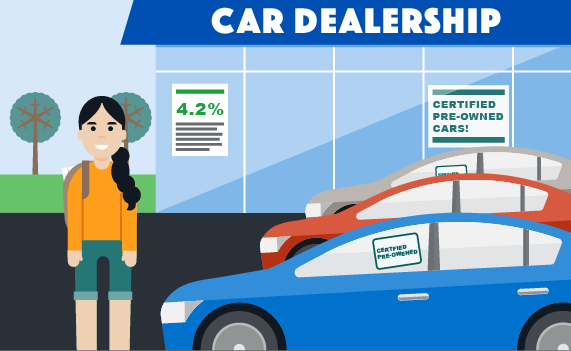This page includes information from the following federal government agencies: Consumer Financial Protection Bureau, Department of Labor, Department of Transportation, and the Federal Trade Commission.
Your guide to buying a car and to getting an auto loan
Deciding to buy a car is exciting! But it can be a stressful and complicated process. Before you make a big purchase or take out an auto loan, learn how to get the best deal within your budget and avoid problems down the road.
Think about what you’d like to focus on — you'll be able to prioritize your goals at the end. Look out for money-saving tips along the way.
Meet Mya and Frankie—they’re here to help you navigate the car-buying process to make it feel a little less overwhelming.
Calculating your budget
While it’s tempting to head straight to the dealership, taking the time to figure out your budget is an important first step.

Mya checks her budget first to avoid problems down the line
Mya needs a car fast so she can get to her new job. But first, she needs to make sure she can afford all the expenses that come with a car, such as:
- Loan payments
- Insurance
- Gas
- Maintenance
- Emergency expenses (like a flat tire or cracked windshield)
The trick is making sure that the she can afford the monthly payments but also adding up all of the payments over time. She doesn't want to end up paying too much in the long run.
Mya knows the total cost of buying the car is just as important as the monthly payment amounts. The maximum total amount she thinks she would be willing to pay for a used car, over time, is $8,500. Keeping that number in mind, she also calculates her monthly maximum. If she can’t make her monthly payments, she could be charged late fees, hurt her credit score, have her car repossessed, and even be sued.
Mya completes a budget and thinks she can afford about $350 a month, which breaks down to:
- $250 for loan payments
- $100 for other expenses like gas, insurance, etc.
She plans to keep these numbers to herself. When she goes into a dealership she’ll need to negotiate, which she can’t do if the dealer knows the maximum she’s willing to pay.
When she compares different cars, she knows that she would rather go with a higher monthly payment, within her budget, if that means she pays a lower total cost and has a shorter loan term.
Your checklist
Mya checked her budget first to figure out how much she could afford. Be sure you start with your budget, too.
Shopping for loans
Shopping for and comparing auto loans can be a complicated process for anyone, especially a first-time borrower. You actually have more control in the situation than you think. You can ask questions as well as negotiate the terms of the loan, including interest. And you always have the right to walk away if you want to look for other options.

Frankie negotiates his loan rate
Frankie checked his credit score, but assumed it wasn’t good enough to qualify for a loan. He then remembered his friend was able to get pre-qualified despite having a low credit score, which inspired Frankie to try.
He called and visited a few different banks and credit unions, as well as online lenders. This way Frankie can get estimates of loan terms with each lender even if he didn’t have an account with them. Frankie isn’t obligated to go with any of these loans but getting pre-qualified for an auto loan with a certain interest rate may give Frankie more negotiating power when he gets to the car dealership.
At the dealership he started the negotiation by insisting the dealership provide him with a lower interest rate in order to compete with the quotes from other lenders.
Your checklist
Frankie shopped around for the best rate. Here are some steps you can take to make sure you’re getting the best loan for you.
Shopping for cars
Ah, the exciting part — car shopping! Do some research on different models and features, then test-drive a few different cars until you find one that best fits your budget and lifestyle.

Mya shops around for a certified pre-owned (used) car in good shape
Mya is eager to start car shopping but she’s worried about being rejected for a loan because of her credit history.
At first, she plans to look at two options:
- Go to a local dealership
- Buy from a friend of a friend who has a car they want to sell
She finds a dealership near her apartment that is selling a car she’s always liked. Then she remembered that her cousin bought that same car last year. It broke down a week later and her cousin still had to make all the monthly car payments.
Mya wants to avoid this problem. She goes home to research her favorite car models online, comparing prices and features. Armed with her budget and a list of models and features she is interested in, she visits a few more dealerships to test-drive several certified pre-owned and to help her find the best deal for her needs.
Your checklist
Shop around like Mya did before making a decision, even if you feel rushed or pressured to buy a car fast.
Confirming details before you drive away
You’re so close! Just a few last steps to make sure you’re ready to drive away in your new car.

Frankie says no to add-ons
Frankie has money saved for a down payment and extra money saved for future car payments. As he’s getting ready to sign all the final paperwork, the car dealer encourages him to buy add-ons. They all sound nice — an extended warranty, paint protection, window etching — but does he really need them?
Frankie reviews his options and realizes he doesn’t need these add-ons and they weren’t accounted for in his budget. Not only would he have to pay for the add-ons, he’d also have to pay interest on them since they would be added to his monthly loan payments.
He declines the add-ons and reviews his paper work one last time. He’s finally ready to drive off the lot with his first car.
Your checklist
Frankie turned down add-ons and negotiated for the best price on his car. Here’s what you can do to make sure you get the best value, too.
Create your own personalized car-buying checklist
We know there’s a lot to consider but choosing a few goals to focus on first will help make the process feel more manageable.
Select a few goals
Choose at least one goal and up to five goals.
My Car-Buying Checklist
There’s a lot to consider when buying a car. Focus on a few goals first, and once you’ve had a chance to complete these goals, revisit the original checklist and decide what you’d like to focus on next.
I'm working on these goals first:
| Goals | Things to keep in mind |
|---|
I’ll consider these goals next:
| Goals to consider next: |
|---|
Still have questions about auto loans?
Learn more about the auto loan process in this guide.
